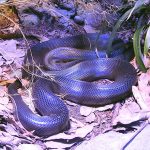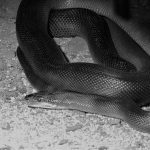WATER PYTHON
The Water Python: A Fascinating Australian Reptile
Introduction
In the dense rainforests and wetlands of northern Australia, a remarkable creature glides through the underbrush and waters—the water python (Liasis fuscus). This non-venomous snake, also known as the brown water python, captivates with its unique adaptations and behaviours.
Physical Characteristics
Adult water pythons typically measure between 2 to 2.5 metres in length, though some individuals can reach up to 3 metres. They possess a robust, muscular build with a head slightly distinct from the neck. Their scales are smooth and glossy, exhibiting a dark blackish-brown dorsal coloration that transitions to a dull to bright yellow on the belly. The throat is cream-colored, and the upper labials are light grey-brown with dark brown or black spots.
Habitat and Distribution
Water pythons are primarily found in the northern regions of Australia, including the Kimberley district of Western Australia, the Northern Territory, and Queensland. They inhabit areas near permanent water sources such as rivers, swamps, and billabongs, often observed in reed beds. Their distribution also extends to the Sir Charles Hardy Islands, Cornwallis Island in the Torres Strait, and parts of Papua New Guinea and Indonesia. (wareptilepark.com.au)
Behaviour and Diet
Despite their name, water pythons are not exclusively aquatic. They are primarily nocturnal, seeking shelter during the day in hollow logs, riverbank dens, and dense vegetation. When startled, they often flee into nearby water. As opportunistic feeders, their diet includes small to medium-sized mammals like rats and bandicoots, birds, reptiles, and their eggs.
Reproduction
Mating occurs during the dry season, typically in July and August. Following a gestation period of about a month, females lay an average of 12 eggs. The eggs incubate for 57 to 61 days before hatching, with each hatchling measuring approximately 30 centimetres in length.
Lifespan
In the wild, water pythons can live for 20 to 30 years, though exact lifespans in captivity may vary. (animalinformation.com)
Conservation Status
The International Union for Conservation of Nature (IUCN) lists the water python as a species of “Least Concern,” indicating a stable population.
Interesting Facts
Adaptability: Water pythons are excellent swimmers and can remain submerged for up to 30 minutes while hunting, using their nostrils to breathe. (animalinformation.com)
Habitat Preferences: Despite their name, many individuals are found far from water for most of the year, often in hollow logs, riverbank dens, and dense vegetation.
Conservation Message
While the water python currently enjoys a stable population, it’s essential to preserve their natural habitats to ensure their continued survival. Protecting wetlands and forests not only safeguards these magnificent snakes but also the entire ecosystem they support.
The water python stands as a testament to the wonders of Australia’s wildlife, embodying the intricate balance between species and their environments.




